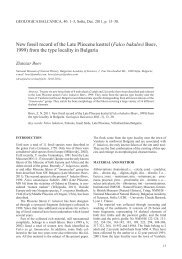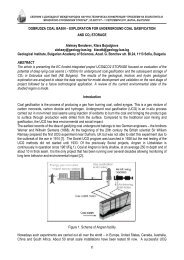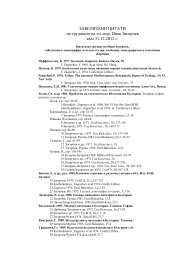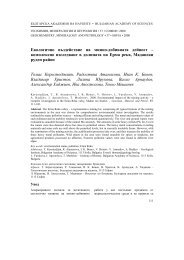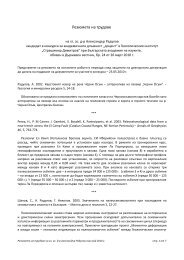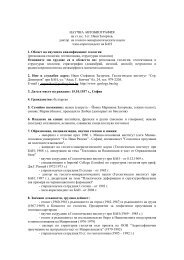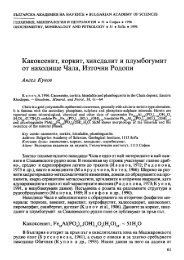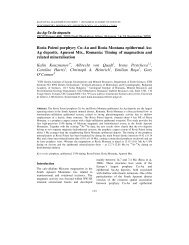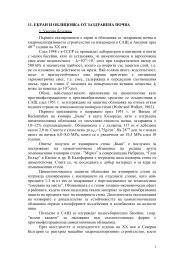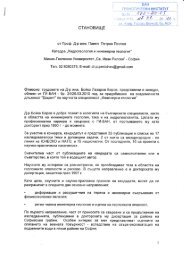2: Hydrothermal ore deposits related to post-orogenic extensional ...
2: Hydrothermal ore deposits related to post-orogenic extensional ...
2: Hydrothermal ore deposits related to post-orogenic extensional ...
Create successful ePaper yourself
Turn your PDF publications into a flip-book with our unique Google optimized e-Paper software.
58<br />
within the Rhodope Massif (see also Ivanov et al.,<br />
2000). The first compressional stage, with large-scale<br />
south-vergent thrusting and amphibolite-facies metamorphism,<br />
was suggested <strong>to</strong> have culminated during<br />
the Middle Cretaceous (110 <strong>to</strong> 90 Ma; Zagortchev and<br />
Moorbath, 1986). The subsequent <strong>extensional</strong> phase<br />
involved exhumation of the thrust complex and formation<br />
of brittle–ductile detachment and synthetic<br />
faults. It was proposed <strong>to</strong> have been initiated in the<br />
Late Cretaceous by the emplacement of weakly<br />
deformed grani<strong>to</strong>id bodies dated at ca. 80 Ma (Peytcheva<br />
et al., 1998a), and then continued with the formation<br />
of Early Tertiary graben structures filled with<br />
continental sediments and volcanic rocks.<br />
Recent geochronological results indicate a m<strong>ore</strong><br />
complicated and even longer tec<strong>to</strong>no-metamorphic<br />
evolution, with overlapping periods of accretion and<br />
dilation (Ricou et al., 1998). They suggest a different<br />
geological evolution of the Central and Eastern Rhodopes<br />
with subduction and metamorphism in the Central<br />
Rhodopes in Jurassic times (185 <strong>to</strong> 140 Ma;<br />
Reischmann and Kos<strong>to</strong>poulos, 2002) and similar<br />
events in the Eastern Rhodopes in Early Cretaceous<br />
<strong>to</strong> Early Palaeocene times (120 <strong>to</strong> 62 Ma; Wawrzenitz<br />
and Mposkos, 1997; Mposkos and Krohe, 2000; Liati<br />
et al., 2002).<br />
The onset of an <strong>extensional</strong> stage, as originally<br />
suggested by Ivanov (1989) for the Central Rhodopes,<br />
seems <strong>to</strong> have occurred in the Late Cretaceous<br />
<strong>to</strong> Early Palaeocene. It is marked by the<br />
metamorphism in the Kimi complex (73 <strong>to</strong> 62 Ma;<br />
Liati et al., 2002) and emplacement of a series of<br />
grani<strong>to</strong>ids at the Biala Reka Dome and in the Rila<br />
area (~70 Ma; Marchev et al., 2004a; I. Peytcheva,<br />
pers. comm., 2003) and undeformed metamorphic<br />
pegmatites (65 Ma; Mposkos and Wawrzenitz,<br />
1995). This magmatism was interpreted by Marchev<br />
et al. (2004a) as the southernmost continuation of<br />
calc-alkaline magmatism in the Srednogorie Zone,<br />
which was followed by series of grani<strong>to</strong>ids of<br />
Early Eocene age (52 <strong>to</strong> 42 Ma; Ovtcharova et al.,<br />
2003). The ages of these granites, intruding what is<br />
interpreted as the upper plate of the Central Rhodopean<br />
Dome, coincide with SHRIMP ages of inferred<br />
metamorphic zircon growth in eclogites and orthogneisses<br />
obtained by Liati and Gebauer (1999) of the<br />
Sidironero complex near Thermes. This suggests that<br />
mid-crustal granite intrusion and mantle <strong>to</strong> lower-<br />
P. Marchev et al. / Ore Geology Reviews 27 (2005) 53–89<br />
crustal metamorphism both occurred at the same<br />
time, prior <strong>to</strong> the <strong>extensional</strong> development of the<br />
c<strong>ore</strong> complex.<br />
Extension along continuously mappable low-angle<br />
detachment faults formed the Central Rhodopean,<br />
Biala Reka and Kessebir metamorphic c<strong>ore</strong> complexes<br />
(Burg et al., 1996; Mposkos and Krohe,<br />
2000; Ivanov et al., 2000; Krohe and Mposkos,<br />
2002; Bonev, 2002), and led <strong>to</strong> the formation of<br />
sedimentary basins. Several unconformities developed<br />
during syntec<strong>to</strong>nic continental and marine sedimentation<br />
(Boyanov and Goranov, 2001) and<br />
exhumation of UHP metamorphic lithologies. In<br />
the area north of the Kessebir dome structure, continental<br />
clastic sedimentation started in Maastrichtian–Palaeocene<br />
time (Goranov and Atanasov,<br />
1992; Boyanov and Goranov, 1994, 2001), which<br />
is coeval with, or slightly later than, Late Cretaceous<br />
metamorphism and grani<strong>to</strong>id magmatism. Rb–Sr<br />
mineral isochrons (Peytcheva et al., 1992; Peytcheva,<br />
1997; Wawrzenitz and Mposkos, 1997) and<br />
40 Ar / 39 Ar dating of muscovite, amphibole and biotite<br />
(Lips et al., 2000; Mukasa et al., 2003; Bonev et<br />
al., in press) from the Variegated and Gneiss–Migmatite<br />
complexes fall in the range 42 <strong>to</strong> 35 Ma,<br />
suggesting that they represent the latest episodes of<br />
uplift and cooling below the closure of these iso<strong>to</strong>pic<br />
systems (~3508C). Similar ages, from Rb–Sr mineral<br />
isochrons of gneisses, constrain the extension and<br />
uplift of the Central Rhodopean Dome near Madan<br />
(Kaiser-Rohrmeier et al., 2004).<br />
3. Distribution and compositional variation of<br />
Tertiary magmatism<br />
Throughout the Rhodope Massif, the latest stages<br />
of extension are manifest by the development of Late<br />
Eocene <strong>to</strong> Oligocene sedimentary basins, followed by<br />
widespread Late Eocene <strong>to</strong> Early Miocene magmatism.<br />
Extensive volcanic and plu<strong>to</strong>nic rocks, typically<br />
truncating the detachment faults in the Rhodope Massif,<br />
form part of an arcuate belt, 500 km long and 130<br />
<strong>to</strong> 180 km wide (Fig. 2), that is known as the Macedonian–Rhodope–North-Aegean<br />
Magmatic Belt (Harkovska<br />
et al., 1989; Marchev et al., 1989; Marchev<br />
and Shanov, 1991). This zone extends <strong>to</strong> the NW in<strong>to</strong><br />
the Dinarides of Macedonia and Serbia (Bonchev,



